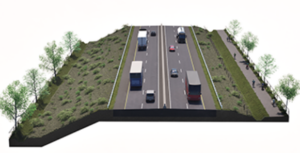A new transport plan for Oxfordshire has set out a vision to deliver a zero-carbon transport network by 2040 and help create a thriving county, tackle inequality, protect our environment and improve the health and wellbeing of residents.
The Local Transport and Connectivity Plan sets out to achieve this by reducing the need to travel and discouraging unnecessary individual private vehicle use through making walking, cycling, public and shared transport the natural first choice.
The plan will provide the backbone for the council’s Cabinet’s commitment to invest in an inclusive, integrated and sustainable transport network for the county. Cabinet members approved the plan at their meeting (on Tuesday, 19 October) and there will now be consultation with local people in November
Councillor Tim Bearder, Oxfordshire County Council’s Cabinet Member for Highways Management, said: “We have a vision to transform transport in Oxfordshire. We want to be less reliant on the car and all enjoy access to vastly improved public transport and gold standard walking and cycling paths.
“We know we face a climate emergency and the least well off are being left behind. Our current network incentivises more carbon waste and is overly focused on expensive single occupancy cars.
“We are miles away from where we should be so this plan represents an exciting milestone in the development of transport network and policies that shifts that balance in favour of something more sustainable. It will take us in a very new direction.
“But we must all recognise that we can’t achieve that change overnight. This plan will be a living document and not set plans in stone with no flexibility for change. It will be regularly reviewed and updated as we assess and re-assess how things are working. It has to be an iterative process that we want the public fully engaged with it.”
Councillor Duncan Enright, Cabinet Member for Travel and Development Strategy, added: “We recognise that to deliver our aspirations there will be considerable challenges. Delivering our vision will not be easy and there will be some tough decisions around how we use existing road space. However, now is the time for an ambitious and comprehensive plan.
“Engagement with organisations and residents in Oxfordshire will be crucial. We thank everyone who has commented so far and welcome feedback on this document so that we can ensure it reflects the needs of people in Oxfordshire. Working together we can deliver a better Oxfordshire for all.”
“We want to hear from as many people as possible, as one of the aims is to make sure everyone has the ability to get around and live well in the county, which is what we mean by tackling inequalities: safe, affordable and convenient transport and connectivity, for family, education, work, opportunity and leisure, for everyone.”
The new plan covers the following areas and ideas:
- Targets to create a zero-carbon transport network and replace one in every three current car trips by 2040.
- Ambitions to increase the number of cycling trips from 600,000 to 1 million in Oxfordshire by 2031.
- Promoting walking and cycling through new and upgraded physical infrastructure and community activation measures. Local walking and cycling infrastructure plans (LCWIPs) already exist for Oxford and Bicester but there are plans to create them in other market towns.
- Investment in our strategic public transport networks and the provision of better and quicker bus and rail services.
- Improving multi-modal travel, including the development of mobility hubs where people can easily change between different forms of transport, so that not all of a longer trip is made by car.
- Work in communities to help people become more active and create healthy places and spaces that encourage people to live healthier lifestyles – including designing neighbourhoods so that vital goods and services are always within a 20-minute walk.
- Improving road safety to create safe and attractive infrastructure for vulnerable road users, including the introduction of 20mph speed limits in residential areas as is already the case in Oxford.
- Improving digital connectivity to support remote working and digital access to services such as GP appointments from home.
- Continuing to improve electric vehicle infrastructure.
- Better use of existing public rights of way, unsurfaced roads, disused railway and canal corridors to create Greenways – one existing example being the Icknield Greenway between Wantage and Harwell.
The council has engaged with the public and key partners on two previous occasions in drafting proposals.
It is proposed that annual monitoring reports are published to demonstrate progress on delivering the plan and progress made against the headline targets. The county council is proposing to undertake a further public consultation on the plan and supporting strategies in due course with final adoption of the plan currently scheduled for spring 2022.






















